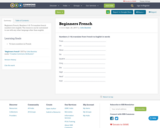
Beginners French.
Numbers 1-10.
To translate french numbers into english.
The resource can be customised to use with any other language other than english.
- Subject:
- Arts and Humanities
- Material Type:
- Unit of Study
- Date Added:
- 09/24/2017

Beginners French.
Numbers 1-10.
To translate french numbers into english.
The resource can be customised to use with any other language other than english.
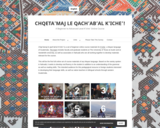
Chqe’tamaj le qach’ab’al K’iche’! is a set of beginner online course materials for K’iche’, a Mayan language of Guatemala
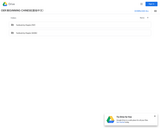
Textbook for a year-long Beginning Chinese course. Chapters are available in word and pdf files.

This is an intermediate workshop designed for students who have a basic understanding of the principles of theatrical design and who want a more intensive study of costume design and the psychology of clothing. Students develop designs that emerge through a process of character analysis, based on the script and directorial concept. Period research, design, and rendering skills are fostered through practical exercises. Instruction in basic costume construction, including drafting and draping, provide tools for students to produce final projects.
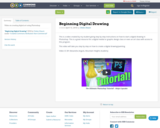
Video on creating digital art using Photoshop
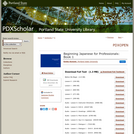
This textbook is designed for beginning learners who want to learn basic Japanese for the purpose of living and working in Japan. Unlike textbooks written primarily for students, whose content largely centers on student life, this book focuses more on social and professional life beyond school.
As a beginning level textbook, this book includes many elementary grammar patterns (Japanese Language Proficiency Test Levels 5 and 4), but the vocabulary and situations are selected specifically for working adults. Explanations are kept concise so as to only cover key points. The main focus is on oral communication and the accompanying audio is to be used extensively. This textbook can be used for self-study, as part of an online course, or as a traditional college course.
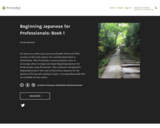
Short Description:
For more accessible and classroom-friendly (Word and PDF) versions of this book, please view and download them at PDXScholar. This Pressbook version primarily exists to encourage others to adapt and adopt Beginning Japanese for Professionals using Pressbooks. This textbook is designed for beginning learners who want to learn basic Japanese for the purpose of living and working in Japan. Corresponding audio files are available for free online via PDXScholar and PSU Media Space.
Long Description:
This is the first book in a three-book series and includes Lessons 0 through 4. Book 2 and Book 3 are available for free download at PDXScholar.
This textbook is designed for beginning learners who want to learn basic Japanese for the purpose of living and working in Japan. Unlike textbooks written primarily for students, whose content largely centers on student life, this book focuses more on social and professional life beyond school.
As a beginning level textbook, this book includes many elementary grammar patterns (Japanese Language Proficiency Test Levels 5 and 4), but the vocabulary and situations are selected specifically for working adults. Explanations are kept concise so as to only cover key points. The main focus is on oral communication and the accompanying audio is to be used extensively. This textbook can be used for self-study, as part of an online course, or as a traditional college course.
Corresponding audio files are available for free online.
Publication of this book was made possible by Portland State University Library PDXOpen Publishing Initiative Grant program.
Word Count: 32569
(Note: This resource's metadata has been created automatically by reformatting and/or combining the information that the author initially provided as part of a bulk import process.)
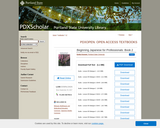
This textbook is designed for beginning learners who want to learn basic Japanese for the purpose of living and working in Japan. Unlike textbooks written primarily for students, whose content largely centers on student life, this book focuses more on social and professional life beyond school.
As a beginning level textbook, this book includes many elementary grammar patterns (Japanese Language Proficiency Test Levels 5 and 4), but the vocabulary and situations are selected specifically for working adults. Explanations are kept concise so as to only cover key points. The main focus is on oral communication and the accompanying audio is to be used extensively. This textbook can be used for self-study, as part of an online course, or as a traditional college course.
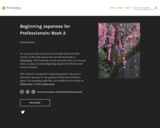
Short Description:
For more accessible and classroom-friendly (Word and PDF) versions of this book, please view and download them at PDXScholar. This Pressbook version primarily exists to encourage others to adapt and adopt Beginning Japanese for Professionals using Pressbooks. This textbook is designed for beginning learners who want to learn basic Japanese for the purpose of living and working in Japan. Corresponding audio files are available for free online via PDXScholar and PSU Media Space.
Long Description:
This is the second book in a three-book series and includes Lessons 0 through 4. https://doi.org/10.15760/pdxopen-14“>Book 1 and Book 3 are available for free download at PDXScholar. Book 1 is also available as a Pressbook.
This textbook is designed for beginning learners who want to learn basic Japanese for the purpose of living and working in Japan. Unlike textbooks written primarily for students, whose content largely centers on student life, this book focuses more on social and professional life beyond school.
As a beginning level textbook, this book includes many elementary grammar patterns (Japanese Language Proficiency Test Levels 5 and 4), but the vocabulary and situations are selected specifically for working adults. Explanations are kept concise so as to only cover key points. The main focus is on oral communication and the accompanying audio is to be used extensively. This textbook can be used for self-study, as part of an online course, or as a traditional college course.
https://media.pdx.edu/tag/tagid/beginning%20japanese%201″>Corresponding audio files are available for free via PSU Mediaspace.
Publication of this book was made possible by Portland State University Library PDXOpen Publishing Initiative Grant program.
Word Count: 31841
(Note: This resource's metadata has been created automatically by reformatting and/or combining the information that the author initially provided as part of a bulk import process.)

This textbook is designed for beginning learners who want to learn basic Japanese for the purpose of living and working in Japan. Unlike textbooks written primarily for students, whose content largely centers on student life, this book focuses more on social and professional life beyond school.
As a beginning level textbook, this book includes many elementary grammar patterns (Japanese Language Proficiency Test Levels 5 and 4), but the vocabulary and situations are selected specifically for working adults. Explanations are kept concise so as to only cover key points. The main focus is on oral communication and the accompanying audio is to be used extensively. This textbook can be used for self-study, as part of an online course, or as a traditional college course.

Short Description:
For more accessible and classroom-friendly (Word and PDF) versions of this book, please view and download them at PDXScholar. This Pressbook version primarily exists to encourage others to adapt and adopt Beginning Japanese for Professionals using Pressbooks. This textbook is designed for beginning learners who want to learn basic Japanese for the purpose of living and working in Japan. Corresponding audio files are available for free online via PDXScholar and PSU Media Space.
Long Description:
This is the third book in a three-book series and includes Lessons 9 through 10. Book 1 and Book 2 are available for free download at PDXScholar and also available as Pressbooks.
This textbook is designed for beginning learners who want to learn basic Japanese for the purpose of living and working in Japan. Unlike textbooks written primarily for students, whose content largely centers on student life, this book focuses more on social and professional life beyond school.
As a beginning level textbook, this book includes many elementary grammar patterns (Japanese Language Proficiency Test Levels 5 and 4), but the vocabulary and situations are selected specifically for working adults. Explanations are kept concise so as to only cover key points. The main focus is on oral communication and the accompanying audio is to be used extensively. This textbook can be used for self-study, as part of an online course, or as a traditional college course.
Corresponding audio files are available for free via PSU Mediaspace.
Publication of this book was made possible by Portland State University Library PDXOpen Publishing Initiative Grant program.
Word Count: 26454
(Note: This resource's metadata has been created automatically by reformatting and/or combining the information that the author initially provided as part of a bulk import process.)

The Beginning Korean 1 textbook is designed for elementary Korean learners to practice and learn how to communicate in Korean. It provides basic grammar, vocabulary, and discourse information that are essential to beginning level students.

The Beginning Korean 2 is designed for elementary Korean learners to practice and learn how to communicate in Korean.
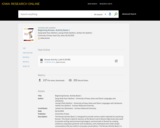
The Korean Activity Book 1 is designed to provide various useful materials for practicing Korean. This book is ideal for learners at the Novice Low to Novice High levels who want to practice writing and pronouncing hangeul, communicate in Korean by creating sentences using basic grammar and vocabulary, and understand and create simple conversations that are useful in everyday conversations. The Korean Activity Book 1 is not a textbook, so it does not include lengthy explanations on grammar or vocabulary. However, it includes a lot of resources of natural conversations and useful vocabularies that are commonly used in contemporary Korean. It also includes useful tips to clarify confusing structures and words & expressions to novice level learners.
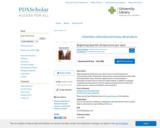
Informed by adult learning theory and social-justice pedagogy, this new OER program focuses on authentic communicative content that is meaningful to students. Its structure supports the needs of inexperienced teaching assistants while also providing flexibility for more experienced instructors. Students are coached about language acquisition, with explicit focus on Interpretive, Interpersonal, and Presentational communication skills. Culture is omnipresent, with OER resources that have been selected with great attention to whose voices are being heard. Representation and inclusion are guiding principles, and tokenism is rejected.

This is an OER textbook developed by Erin Huebener at Spokane Community College.

There are PBIS cards that get progressively harder to fill to earn a reward.

When Banksy shredded his artwork the moment after it sold at auction, he left many questions unanswered. What are we to make of the stunt?
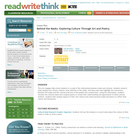
Students research mask-making from various cultures, highlight the masks' connections to cultural practices, compose poetry to reveal their understanding, analyze their own culture, and create personal masks and poetry.
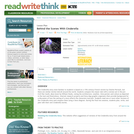
Cinderella without castles, coaches, or ball gowns? Students use versions of Cinderella to explore how the setting of a story--time, place, and culture--affects the characters and plot.